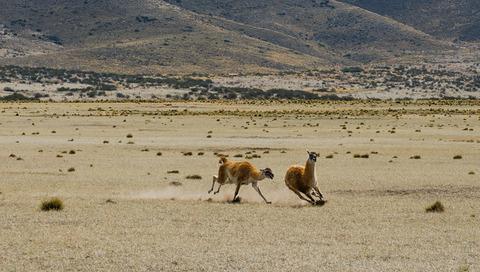Our official English website, www.x-mol.net, welcomes your
feedback! (Note: you will need to create a separate account there.)
Male aggressiveness in a polygynous ungulate varies with social and ecological context
Ethology ( IF 1.3 ) Pub Date : 2020-10-11 , DOI: 10.1111/eth.13100 Antonella Panebianco 1 , Pablo F. Gregorio 1 , Ramiro Ovejero 2, 3 , Antonela Marozzi 1 , Mariel Ruiz Blanco 4 , Leonardo R. Leggieri 1 , Paula A. Taraborelli 5 , Pablo D. Carmanchahi 1
Ethology ( IF 1.3 ) Pub Date : 2020-10-11 , DOI: 10.1111/eth.13100 Antonella Panebianco 1 , Pablo F. Gregorio 1 , Ramiro Ovejero 2, 3 , Antonela Marozzi 1 , Mariel Ruiz Blanco 4 , Leonardo R. Leggieri 1 , Paula A. Taraborelli 5 , Pablo D. Carmanchahi 1
Affiliation

|
Aggression is a social behaviour which can be affected by numerous factors. The quality and quantity of food resources may play an important role in the aggressiveness of territorial ungulates as the defence of these resources influences female choice and mating opportunities. However, the relationship between food resources and aggression remains poorly understood. We assessed the ecological and social factors that influence aggression in Lama guanicoe, a territorial ungulate exhibiting resource‐defence polygyny, during three periods (group‐formation, mating and post‐mating) in the reproductive seasons of 2014 and 2016. We recorded 460 focal observations of territorial (family groups, solitary) and non‐territorial (mixed and bachelor groups) males. We performed analyses at the population level (including all focal observations) and at the group level (each social unit separately), to test whether the factors that influence aggression differ at these different scales. We also identified proxies of vegetation quality as potential predictors of aggression. At the population level, we found that the presence of aggressive behaviour peaked during the mating season and that post‐mating aggression may have been driven by inter‐annual environmental variations. For family groups and solitary males, variables reflecting high vegetation quality/quantity were predictors of aggressive behaviour, reflecting the resource‐defence strategy of this species. Conversely, for mixed‐group males, aggression may be more associated with social instability and group size, although this hypothesis has yet to be tested. Our research reinforces the idea that aggression can occur in multiple contexts depending on male status (e.g. territorial or non‐territorial) and contributes to our understanding of how ecological (i.e. availability of food resources) and social factors influence aggression in a territorial ungulate.
中文翻译:

多齿有蹄类动物的雄性攻击力随社会和生态环境而变化
侵略是一种受多种因素影响的社会行为。粮食资源的质量和数量可能在领土有蹄类动物的侵略性中起重要作用,因为这些资源的防御会影响女性的选择和交配机会。但是,人们对粮食资源与侵略之间的关系知之甚少。我们评估了影响鸟侵略行为的生态和社会因素,在2014年和2016年的繁殖季节中,在三个时期(群体形成,交配和交配后)表现出资源防御多妻制的有蹄类动物。我们记录了460个对领土(家庭群体,单身)和非领土(混合和单身汉群体)男性。我们在人口水平(包括所有焦点观察)和群体水平(分别对每个社会单位)进行了分析,以检验影响侵略的因素在这些不同规模上是否不同。我们还确定了植被质量的代理人可能是侵略的潜在指标。在种群水平上,我们发现侵略行为的出现在交配季节达到顶峰,而交配后的侵略可能是由年际环境变化驱动的。对于家庭团体和单身男性,反映高植被质量/数量的变量是侵略性行为的预测指标,反映了该物种的资源防御策略。相反,对于混合型男性,侵略性可能与社会不稳定和群体规模有关,尽管这一假设尚待检验。我们的研究强化了这样一种观念,即侵略可能会在多种情况下发生,具体取决于男性的地位(例如领土或非领土),并有助于我们理解生态(即食物资源的可用性)和社会因素如何影响领土上有蹄类动物的侵略。侵略可能与社会动荡和群体规模更为相关,尽管这一假设尚待检验。我们的研究强化了这样的观点,即侵略可能会在多种情况下发生,具体取决于男性地位(例如领土或非领土),并有助于我们理解生态(即食物资源的可用性)和社会因素如何影响有蹄类动物的侵略。侵略可能与社会动荡和群体规模更为相关,尽管这一假设尚待检验。我们的研究强化了这样一种观念,即侵略可能会在多种情况下发生,具体取决于男性的地位(例如领土或非领土),并有助于我们理解生态(即食物资源的可用性)和社会因素如何影响领土上有蹄类动物的侵略。
更新日期:2020-12-14
中文翻译:

多齿有蹄类动物的雄性攻击力随社会和生态环境而变化
侵略是一种受多种因素影响的社会行为。粮食资源的质量和数量可能在领土有蹄类动物的侵略性中起重要作用,因为这些资源的防御会影响女性的选择和交配机会。但是,人们对粮食资源与侵略之间的关系知之甚少。我们评估了影响鸟侵略行为的生态和社会因素,在2014年和2016年的繁殖季节中,在三个时期(群体形成,交配和交配后)表现出资源防御多妻制的有蹄类动物。我们记录了460个对领土(家庭群体,单身)和非领土(混合和单身汉群体)男性。我们在人口水平(包括所有焦点观察)和群体水平(分别对每个社会单位)进行了分析,以检验影响侵略的因素在这些不同规模上是否不同。我们还确定了植被质量的代理人可能是侵略的潜在指标。在种群水平上,我们发现侵略行为的出现在交配季节达到顶峰,而交配后的侵略可能是由年际环境变化驱动的。对于家庭团体和单身男性,反映高植被质量/数量的变量是侵略性行为的预测指标,反映了该物种的资源防御策略。相反,对于混合型男性,侵略性可能与社会不稳定和群体规模有关,尽管这一假设尚待检验。我们的研究强化了这样一种观念,即侵略可能会在多种情况下发生,具体取决于男性的地位(例如领土或非领土),并有助于我们理解生态(即食物资源的可用性)和社会因素如何影响领土上有蹄类动物的侵略。侵略可能与社会动荡和群体规模更为相关,尽管这一假设尚待检验。我们的研究强化了这样的观点,即侵略可能会在多种情况下发生,具体取决于男性地位(例如领土或非领土),并有助于我们理解生态(即食物资源的可用性)和社会因素如何影响有蹄类动物的侵略。侵略可能与社会动荡和群体规模更为相关,尽管这一假设尚待检验。我们的研究强化了这样一种观念,即侵略可能会在多种情况下发生,具体取决于男性的地位(例如领土或非领土),并有助于我们理解生态(即食物资源的可用性)和社会因素如何影响领土上有蹄类动物的侵略。











































 京公网安备 11010802027423号
京公网安备 11010802027423号